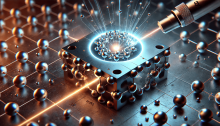A new five-year, $5 million government- and industry-funded project at UBC will see researchers in the departments of Earth and Ocean Sciences, Computer Science and Mathematics designing the next generation of seismic imaging technology.
The Dynamic nonlinear optimization for imaging in seismic exploration (DNOISE II) project received funding from the Natural Sciences and Engineering Research Council of Canada this October, and matching support from industry partners including BG Group, BP, Chevron, ConocoPhillips, PetroBras, Total SA and WesternGeco.
“This work will address fundamental issues related to the quality and cost of seismic data acquisition, and to the ability to mine exceedingly large data volumes,” says associate professor Felix Herrmann, director of the UBC-Seismic Laboratory for Imaging and Modeling and principal investigator on the project.
"These investments will help keep UBC and Canada at the forefront of advancing seismic imaging technology by adapting transformational developments in applied and computational harmonic analysis, convex optimization and geophysical inversion."
The interdisciplinary project involves researcher from across UBC Science, including Michael Friedlander (Computer Science), Ozgur Yilmaz (Mathematics) and Herrmann (Earth and Ocean Sciences). Much of the funding will provide research support for graduate students and postdoctoral fellows.
More on the DNOISE II project:
http://slim.eos.ubc.ca/index.php?module=articles&func=display&aid=345
Musqueam First Nation land acknowledegement
We honour xwməθkwəy̓ əm (Musqueam) on whose ancestral, unceded territory UBC Vancouver is situated. UBC Science is committed to building meaningful relationships with Indigenous peoples so we can advance Reconciliation and ensure traditional ways of knowing enrich our teaching and research.
Learn more: Musqueam First Nation
Faculty of Science
Office of the Dean, Earth Sciences Building2178–2207 Main Mall
Vancouver, BC Canada
V6T 1Z4


